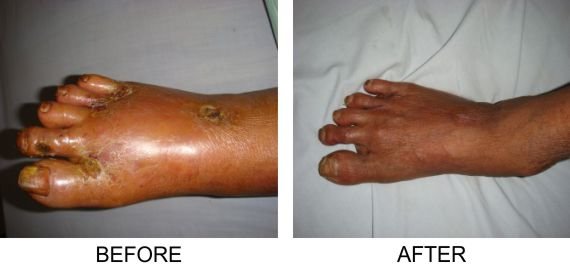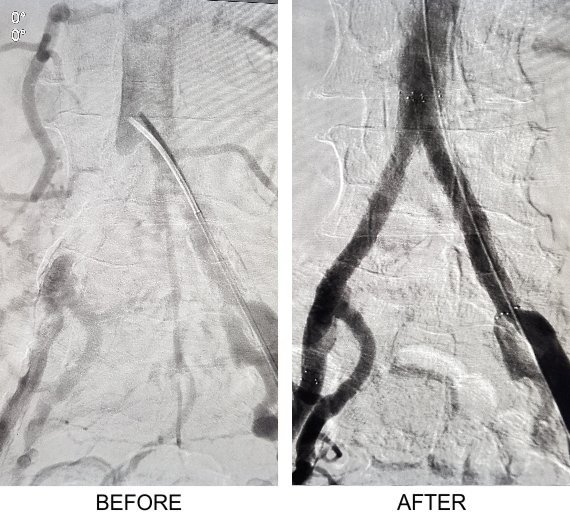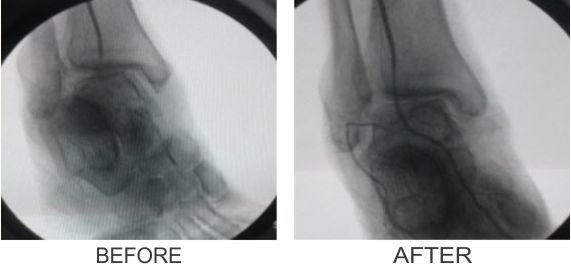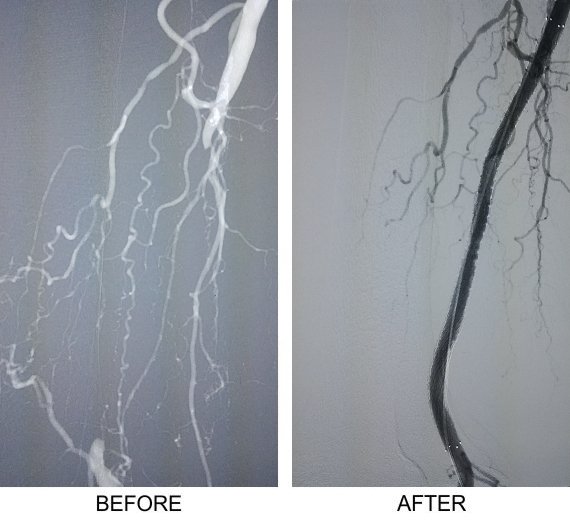Leg Bypass To Prevent Amputation









If your legs pain while walking, this may be the first indicator of a leg attack, known in medical terminology as Peripheral Arterial Disease (PAD).
Arteries in the body can slowly become narrowed and blocked as a consequence of age, smoking, high blood cholesterol or diabetes. Blockage in the heart arteries can cause heart attack. Similar blockage in the leg arteries gives rise to leg attack.
In the initial stages of blockage, patients do not have any major problems and may attribute pain on walking (claudication) to old age, weak muscles or arthritis. However, if left undiagnosed and untreated, PAD often ends with severe rest pain and ulcers or gangrene and eventual amputation of the leg.
Who is at risk of PAD?









The risk of atherosclerosis increases with the following risk factors. If you have more than two of these risk factors, regular examination with an ABI test will detect PAD in early stages.
What can happen due to PAD?


Known to be a naturally progressive disease, as time goes by and the blockage increases, patients may develop increasing severity in the leg pain with slow healing of ulcers or onset of black patches in toes or foot (Gangrene)
In earlier times, patients with gangrene were advised for amputation of leg, either below or sometimes above the knee. But with newer advances in vascular surgery, procedures are now being performed to prevent amputation. After all, it’s not your legs, it’s your life!
How do you know if you have PAD?









After a careful questionnaire and examination, a vascular specialist will perform any of the following tests to diagnose and confirm PAD.
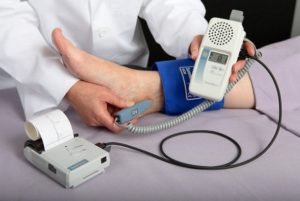

ABI (Ankle-Brachial pressure Index)
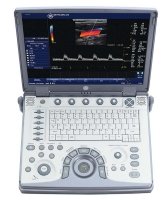

Color – Doppler
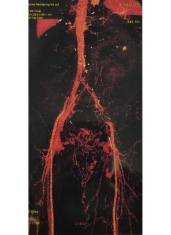

CT Angiography
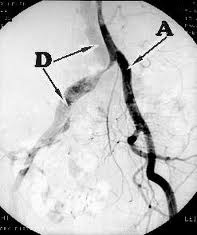
Digital Subtraction Angiography
What treatment is effective in preventing amputations?









Your vascular specialist can guide you and help you provide a suitable balanced option between the different available procedures based on multiple factors including age, co-existent problems, level of blockages and availability or expense of devices.
- Angioplasty: Minimally invasive techniques through needle punctures and utilising endovascular balloons or stents have revolutionised the treatment of PAD patients. There have been substantial developments in the skills and resources utilised for endovascular procedures over the past decade. Continuously upgrading expertise has led to development of drug coated balloons, atherectomy devices and vascular mimetic stents which promise to deliver better results in reduced recovery time and are less painful. They are now regularly used for treatment of leg arterial blockages.
- Bypass: Often, long segment blockages or multilevel blockages are better dealt with by surgical bypass. Surgical bypass can be performed by using patients own vein or a synthetic graft and can be performed from the abdomen to the foot depending on the level and extent of arterial blockage. These procedures will not cure PAD, but they can improve the blood circulation to your legs and your ability to walk and thus prevent amputation.
- Medicines: Not all patients require major surgery if diagnosed in time. In addition to changing your lifestyle after a diagnosis and controlling of risk factors like diabetes and hypertension, certain medicines are useful in the initial stages of PAD.
- Walking exercises: Exercise strengthens the leg muscles which are out of shape and weak. It is useful for improving claudication distance and helps you lead a healthy life. However, this may not be suitable for patients who have ulcer or gangrene.
No matter what your age, early diagnosis and treatment of vascular disease can improve the quality of your life.
We strongly recommend you to stay updated on the latest information and treatments in vascular care. You never know when you need to know.
Frequently asked questions









Narrowing or blockage of the vessels that carry blood from the heart to the lower extremities i.e. legs is called Peripheral arterial disease (PAD). PAD can be treated by expert vascular surgeons and the main goal of treatment for PAD (Peripheral Artery Diseases) are to reduce symptoms and improve Artery health to reduce associated risk such as Heart Attack and Stroke. Treatment for PAD includes lifestyle changes, medications or in some condition surgical intervention.
LifeStyle changes: Your doctor may suggest few lifestyle changes to improve on symptoms, especially early in the course of Peripheral Artery Disease, this lifestyle changes includes quitting smoking, walking or doing other exercise on a regular basis to improve your artery health.
Medications: In some conditions of Peripheral Arterial Disease (PAD), your doctor may suggest some course of medicines includes Cholesterol Drugs, Blood Pressure drugs, medication to control blood sugar, medication to prevent blood clots or medication for leg pain. The medication is dependent upon the persons associated comorbid conditions.
Surgery or other procedures: In some cases, your doctor may suggest to go for angioplasty or surgery which is necessary to treat Peripheral Artery disease that causing claudication.
Stage 1: Asymptomatic PAD
In this stage of PAD, the patient is diagnosed incidentally or as part of a cardiovascular check up and blockage within the artery in the extremities has been found. This stage would be considered diagnosis of PAD at an early stage and gives the greatest opportunity to patient as well as doctor to slow or stop the condition’s progression through lifestyle modification suggestions.
Stage 2: Claudication
In this stage of PAD, Patients usually begin to feel discomfort and pain in their lower limbs / legs and most often in their calves and the pain or discomfort can be reproduced every time the patient does some activities or exercise and the pain / discomfort typically goes away after rest. In this stage the patient gets occlusion in the peripheral arteries, and it is during this time the doctor might begin to explore potential treatment options including lifestyle changes.
Stage 3: Critical Limb Ischemia
Critical limb ischemia stage, PAD produces pain at rest and even through the night. In this stage skin sores or ulcers may begin to appear as a result of blood not reaching the extremities resulting not allowing for proper healing.Beyond this stage, patient can end up with gangrene or blackening of toes or feet. At this stage, if the patient is healthy enough, procedure known as balloon angioplasty with stenting is performed by expert which is a minimally invasive procedure, in some cases a bypass will be required if the occlusion cannot be opened with balloon angioplasty.
Acute limb ischemia is also known as ALI involves the sudden loss of blood flow to the extremities causing the limb’s rapid deterioration. In this stage patients use to have significant pain along with tingling sensations, loss of pulse, cold in the extremities, the extremity turning pale, and ultimately paralysis. In this stage PAD become an emergency, and without immediate care, there is a significant chance that the limb will require amputation or have life threateningcomplications.
PAD can be a deadly disease if left untreated, so it’s important to take a PAD diagnosis seriously and treated at the right time.There are two ways that PAD can decrease life expectancy: by raising the likelihood of unhealthy arteries elsewhere in the body and by increasing the risk of amputation. PAD disease life expectancy is difficult to determine but due to these circumstances,1 in 5 people with PAD (Peripheral Arterial Disease) will suffer from a heart attack, stroke or death within five years if left untreated.
Yes, Peripheral Arterial Disease (PAD) is a serious condition if not diagnosed and treated at the right time.
Yes, studies have shown that exercise or walking can improve both symptoms as well as progression of PAD.
Yes, at some stage of PAD, Peripheral Arterial Disease is terminal disease but at the same time PAD is not immediately life threatening. The process of atherosclerosis that causes it can lead to serious and potentially fatal problems.
Yes, Patients with Peripheral Arterial Disease have an increased risk of angina, myocardial infarction, stroke, congestive heart failure and death compared to patients without having PAD.
Yes, undiagnosed and untreated Peripheral Arterial Disease can lead to more complications and worsen over time. This is the most common cause for major amputation of limbs.
Gallery










Femoro Popliteal Bypass using Vein Graft
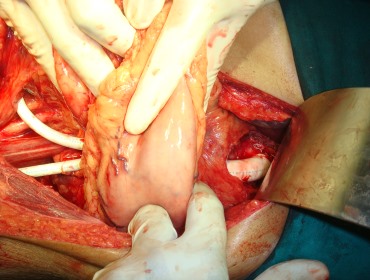

Supra-Celiac Aorto Femoral Bypass
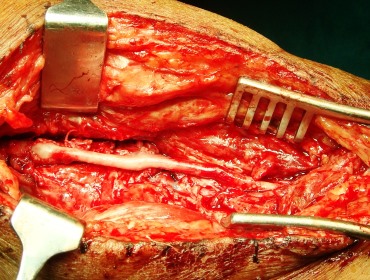

Popliteo-Distal Bypass
Successful Treatments









